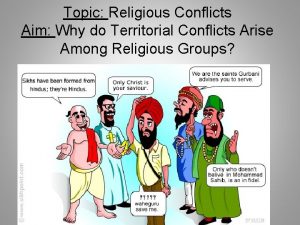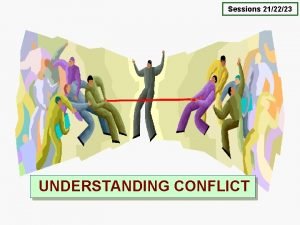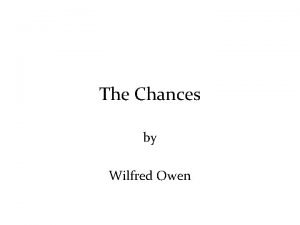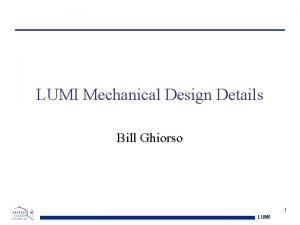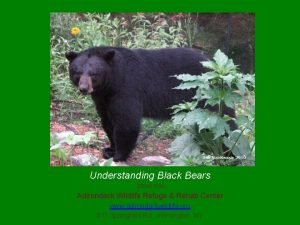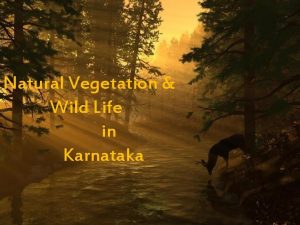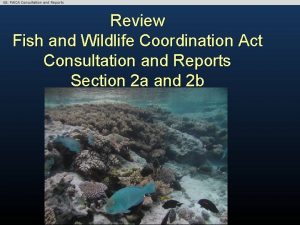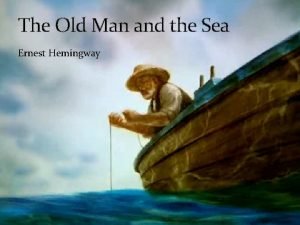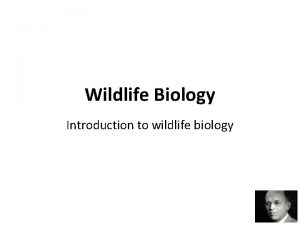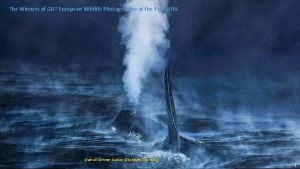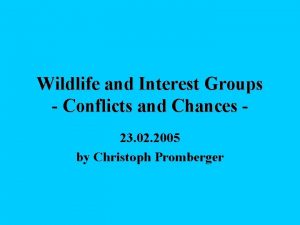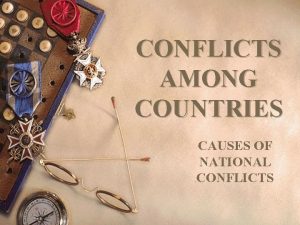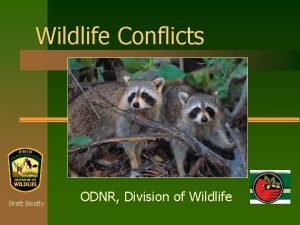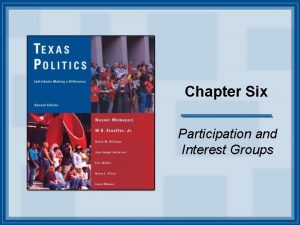Wildlife and Interest Groups Conflicts and Chances 23


































- Slides: 34

Wildlife and Interest Groups - Conflicts and Chances 23. 02. 2005 by Christoph Promberger

Wildlife and Humans Wildlife and humans have a long-lasting relationship. Most important for humans were utilitarian aspects of wildlife (food, competitors) and mystic aspects (sacred animals/evil animals). In our modern, Central European life, wildlife has decreased in importance and has changed towards a less utilitarian way to look at it.

Wildlife and Humans In other countries, wildlife is still an important issue: In North America or Scandinavia, wildlife is an important issue for the broader public and a number of specific wildlife agencies exist with numerous staff and excellent budgets. In rural areas, wildlife has a higher importance in comparison to urban areas, but the utilitarian aspect is much stronger.

Who Am I? A few words about myself: - I grew up in rural Bavaria, next to the Czech border - Forestry degree (Univ. Munich), M. Sc. study about wolves in the Canadian North - 1993 -2003 Carpathian Large Carnivore Project (Romania) - 2004 own horse riding centre - 2005 new conservation project “Sinca Noua”

The Carpathian Large Carnivore Project A conservation and research project in the east-central Romanian Carpathians with the overall goal to enhance the relations between large carnivores and humans by solving conflicts, creating economic advantages through the existence of l. c. s and creating understanding.

The Carpathian Large Carnivore Project We divided the project in four general fields of activities: Research about direct interactions between l. c. s and people

The Carpathian Large Carnivore Project We divided the project in four general fields of activities: Research about direct interactions between l. c. s and people Rural development/development of eco-tourism Direct conservation activities to resolve conflicts (e. g. electric fences for livestock) Environmental education and school programmes

The Carpathian Large Carnivore Project Some results of the project - Basic understanding of how l. c. s and people can cope – not a problem for l. c. s, people are the crucial factor

The Carpathian Large Carnivore Project Some results of the project - Basic understanding of how l. c. s and people can cope – not a problem for l. c. s, people are the crucial factor - Electric fences are a good tool to decrease conflicts between wolves/bears and livestock - Wolves and bears are very valuable to promote an area for tourism, 150 jobs created

The Sinca Noua Project Sinca Noua is a small village (1, 800 inhabitants, 9, 000 ha surface, altitude 6001, 600 m) at the foot of the Carpathian Mountains. The village wants to develop itself into an eco-village in order to conserve the area for the next generations and to enhance the economic situation for its inhabitants without compromising the quality of life.

The Sinca Noua Project The project is in its very early stage, but intends to create a model area, where conservation of nature and sustainable economic development for the people go hand in hand support each other.

The Sinca Noua Project Planned activities: - create a large protected area (wilderness reserve) - certification of the local agriculture as “organic agriculture” and of Sinca Noua as an eco-tourism destination - creation of a small-scale industry in food processing (milk, meat, fruits, forest fruits) -development of Sinca Noua as an eco-tourism destination, services provided by local people

Wildlife and Humans Where are conflicts and chances? Livestock and Agriculture Hunting Tourism

Wildlife and Humans Where are conflicts and chances? Most important reason for conflicts is a lack of communication and a lack of understanding of each others interests. Where local people are expected to accept conservation measures, conservation managers have to understand the needs of local people and provide solutions.

Wildlife and Humans Conservation can hardly ever be achieved by fighting against local people but by creating partnerships. Conservation reaches acceptance, where local people have a personal advantage of a protected area.

Hunting Positive sides of hunting: - control against poaching - control of nuisance animals - use of a renewable resource - leisure activity - economic input for a region

Hunting Positive sides of hunting: - control against poaching - use of a renewable resource - leisure activity - economic input for a region Negative sides of hunting: - killing of otherwise reproducing animals - possible shift in species occurrence - disturbance and interruption of social structure

Hunting Restrictions upon hunting for conservation issues always causes conflicts with hunters Effects: - less acceptance for protected areas - increase of poaching Poaching has always a social component and is a way to articulate protest. Since poaching can be done with gun, trap or poison, it is very hard to control.

Hunting Possible solutions to decrease conflicts with hunters: - accept hunting in parts of the protected area - accept hunting for various species (e. g. allow a wild boar hunt/year as a big event) - include hunters in wildlife monitoring

Livestock and Agriculture Especially large carnivores and wild boar can create substantial damage to livestock and crops But there are good protection methods against wildlife damage

Livestock and Agriculture In Romania, where over 5, 000 sheep graze the alpine pastures during the summer, there is at the same time the highest concentration of large carnivores in Europe: 5, 000 bears

Livestock and Agriculture In Romania, where over 5, 000 sheep graze the alpine pastures during the summer, there is at the same time the highest concentration of large carnivores in Europe: 5, 000 bears 3, 000 wolves

Livestock and Agriculture In Romania, where over 5, 000 sheep graze the alpine pastures during the summer, there is at the same time the highest concentration of large carnivores in Europe: 5, 000 bears 3, 000 wolves 2, 000 lynx

Livestock and Agriculture Still, damage is acceptable, only 1 -2% of the sheep are killed by carnivores each year. This is due to the traditional livestock protection methods, still executed in Romania

There is no flock of sheep in the mountains without several guarding dogs

Livestock and Agriculture Damage occurs mainly, if - the shepherds are inattentive - the camps are too close to the forest - the dogs are bad quality

Livestock and Agriculture In many countries, damage compensation is being paid. Unless this is linked to protection methods, it is not a useful tool to mitigate conflicts between large carnivores and the local people More successful is, if money is paid when carnivores successfully breed in an area or when protection methods are being co-funded by the state

Livestock and Agriculture Electric fences are the easiest and most successful tool to protect herds or crops. Some data: - costs ca. 500 Euro/ha (~ 7 sheep) - powered with 12 V car batteries - battery lasts ca. 3 -4 weeks before it has to be recharged

Eco-tourism has two components: - no negative environmental impact - local people benefit from the tourism Chance: - local acceptance for protected areas - sustainable development Danger: - non-local investors take over - might get out of hand

Eco-tourism In developing eco-tourism the following ingredients are necessary: A good story – Why should a visitor come to this specific area? Tools to develop a proper infrastructure Tools to prevent unwanted developments A good marketing strategy – Get the word out!

Eco-tourism There are three levels to work on: 1. The local level Build/enhance the infrastructure Train people Create awareness of what eco-tourism means Organise the people (e. g. Tourism Association)

Eco-tourism There are three levels to work on: 2. The national level Get national gov’t support Get national media coverage (create pride on the local level) Attract national visitors

Eco-tourism There are three levels to work on: 3. The international level Get international support (NGO’s) Get international media coverage (attract foreign visitors) Attract international funding

Thank you very much for your attention!
 Why do territorial conflicts arise among religious groups
Why do territorial conflicts arise among religious groups Possible conflicts between stakeholder groups
Possible conflicts between stakeholder groups What is conflict
What is conflict Lesson 3 taking responsibility for your health
Lesson 3 taking responsibility for your health How are ethnic groups and religious groups related
How are ethnic groups and religious groups related Real vs nominal interest rate
Real vs nominal interest rate 0 965
0 965 The chances wilfred owen analysis
The chances wilfred owen analysis Second chances lumi
Second chances lumi More choices more chances
More choices more chances Free rider interest group
Free rider interest group The nature of interest groups
The nature of interest groups Chapter 9 section 3 interest groups at work
Chapter 9 section 3 interest groups at work A virtue of interest groups is that
A virtue of interest groups is that Interest groups linkage institutions
Interest groups linkage institutions Proliferation of interest groups
Proliferation of interest groups State two characteristics of interest groups
State two characteristics of interest groups Interest groups vs social movements
Interest groups vs social movements Chapter 9 section 2 types of interest groups
Chapter 9 section 2 types of interest groups Are interest groups linkage institutions
Are interest groups linkage institutions Interest groups
Interest groups Federalist 10 interest groups
Federalist 10 interest groups What are interest groups
What are interest groups Fundamental goal of interest groups
Fundamental goal of interest groups Nominal.interest rate
Nominal.interest rate Adirondack wildlife refuge and rehab center
Adirondack wildlife refuge and rehab center Mixed forest of karnataka
Mixed forest of karnataka Fish and wildlife coordination act
Fish and wildlife coordination act Anwr drilling pros and cons
Anwr drilling pros and cons Chapter 9 lesson 2 resolving conflicts
Chapter 9 lesson 2 resolving conflicts Chapter 9 resolving conflicts and preventing violence
Chapter 9 resolving conflicts and preventing violence The old man and the sea criticism
The old man and the sea criticism The crucible act 2 literature focus types of conflict
The crucible act 2 literature focus types of conflict Manipulative management wildlife
Manipulative management wildlife Mario cea sanchez
Mario cea sanchez
